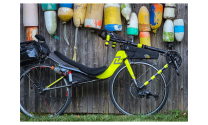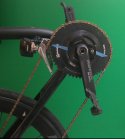@Jim Parker thanks for posting this. It also made me take another look at my setup posted above.
I also re-read this study:
Biomechanical study chainrings - release 2.pdf. The authors created a mechanical model for evaluating non-circular chainrings, and suggested starting with the cranks roughly perpendicular to a standard bicycle seat tube when the major axis was vertical (i.e., perpendicular to a level chainline):
I did not have it set up like
@Beano and you did, with the major axis (largest diameter) aligned with maximum leverage. It was actually set up more like the chainring designer originally intended, with the chain engaging the major axis after the pedals passed perpendicular to the imaginary seat tube line (between the hip joint and the crank axis). That roughly corresponds to the point of maximum leverage (assuming your hip joint is in line with the seat tube centerline as in standard bike design/fit).
I realized I have more adjustments than I thought with the 5 chainring bolts. The chainring has 180-degree symmetry, so the adjustments are 180/5=36 deg, not 72 deg as I had thought. That's not as fine as the 1 deg increments of your Rotor setup, but it lets me get within +/- 18 deg of any desired "ideal". And I don't think anybody knows the ideal angle with a lot more precision!
But it does force me to choose between putting the major axis slightly before or after the imaginary seat tube line. I advanced the timing so the taut side chain is perpendicular to the major axis just before the cranks are perpendicular to the imaginary seat tube angle:

My chainline is not as vertical as yours, even though I have the long chainstays. Also, I don't have to mark the major axis with tape, because the pointy end of the ogive is pretty obvious on its own!

After going over to the other side, I did a couple of long rides with this advanced timing setup, and my initial impression is that I like it better than the retarded timing setup. I think my last ride was my best ever on the V20! So I will keep it this way for a while before I try going back to retarded timing, or a round ring for comparison.
Note that my primary reason for using the ogival rings is for climbing, not for top speed, so my use case and experience may be different. That's why I have shown the chainline in the lowest gear (50t/50t).
Also, I have not tested for traction effects, which may be more important, i.e., which setup has less wheel slip to allow climbing steeper slopes? A related primary factor would be pedal steer, which would trump any other considerations. I didn't notice any pedal steer issues, but I would need to do more testing to be sure.







